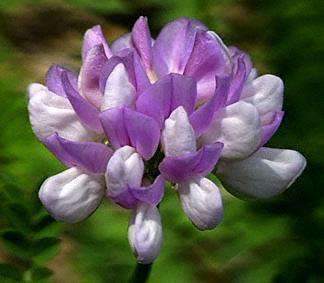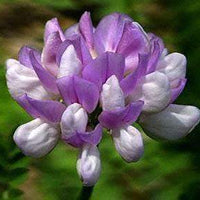
- When to plant:
- Spring, Fall
- Fertilizer:
- Varies
- Seeding rate:
- 5 - 15 lbs. per acre
- Overseeding rate:
- 3 - 5 lbs. per acre
- Seeding depth:
- 1/4 inch
- Ideal ph:
- 5.5 - 7.0
- Gmo:
- No
- Inoculant needed:
- No
- Coated or raw:
- Coated
- Lifecycle:
- Perennial
- Climate zones:
- Cool Season, Transition Zone, Warm Season
Crown Vetch is a cool season, hardy, perennial legume. Crown Vetch is not a true vetch, although it resembles common and hairy vetch. Crown Vetch spreads from rhizomes and will form a dense cover. It has been used for soil stabilization and as an ornamental landscaping for many years.
Product Information
- Application or Use: Cover Crop, Cattle Forage, Livestock Grazing, Erosion Control, Ornamental, Hay Production
- Germination Time: 7 - 14, days, under optimal conditions
- Growing Locations: Warm Season, Transition Zone, Cool Season
- Height: 1 - 2 feet
- Sunlight Requirements: 6+ hours, full sun for best results
- Advantages: Non-bloating legume that has a wide range of climatic adaptations, but its performance is superior on well-drained soils.
- When to Plant: Recommended planting time is fall and spring when night time temperatures are consistently below 65 degrees.
Product Details
- Non-bloating legume
- Wide range of climatic adaptations
- Tolerant of both low pH and low fertility soils
- Highly responsive to lime, phosphorus and potassium
- Adapted to road bank stabilization and erosion control
Product Information
Crown Vetch has a wide range of climatic adaptations, but its performance has been superior on well-drained soils. It is tolerant of both low pH and low fertility soils. However, it is highly responsive to lime, phosphorus and potassium. Crown Vetch is particularly adapted to road bank stabilization and erosion control. At the present time, this seems to be one of the best uses for the plant. In recent years, Crown Vetch has been considered as a source of forage for livestock.
It is a non-bloating legume. Some research has indicated that the young growth is palatable but that more mature growth is not readily accepted. Chemical analysis of Crown Vetch hay has shown that its crude protein and crude fiber content is similar to that of other legume hays.
Once the seedlings are established, relatively few Crown Vetch seedlings per acre will result in good stands because of its spreading habit due to the strong, vigorous rhizomes. Crown Vetch will persist under hay and grazing conditions if soil drainage and fertility is adequate. Its slow recovery after hay harvest suggests that it should not be overgrazed. A 3- to 4-inch stubble left after harvest is desirable to keep it in a productive state. Crown Vetch grows best on well-drained soils that have been limed as for clover. Hay yields have been less than alfalfa, so potash and phosphate should be applied as for red clover. Crown Vetch is toxic to horses because of the presence of nitroglycosides. If consumed in large amounts, it can cause slow growth, paralysis, or death.
*Product packaging may appear different than what is pictured.
The usual seeding rate is 5 to 15 pounds per acre. Seed prices are high, so you will want to keep seeding rates low. If low seeding rates are used, techniques designed to ensure maximum plant establishment are of the utmost importance. These techniques include the use of a seed inoculant, chemical weed control and special seeding equipment. If possible, apply lime, phosphate and potash based on red clover requirements. Do not use nitrogen because it will stimulate weeds more than the young Crown Vetch plants.
Seeding Methods
1. Spring seed on a prepared seedbed from March 15 to May 15. If possible, the sod should be fall plowed to control weeds and provide a firm seedbed.
2. Seed on a litter or mulch from dead Sudan grass from October to April.
3. Seed in early spring on a prepared seedbed.
4. Broadcast Crown Vetch seed and roll or pack the soil. You may also seed in rows and cultivate to control weeds. The creeping ability of Crown Vetch will enable it to fill the rows.
When choosing to start a new lawn, remove old vegetation by using a de-thatcher, power rake or tiller to kill the existing vegetation. Rake or drag the area to remove debris and dead grass for a clean area. Ensure the soil is leveled and loosened to allow the seed to have good soil contact once spread on a clean seed bed.
If you have an area with heavy weed coverage, we recommend starting fresh by killing and removing the existing vegetation. If you choose to use chemicals, herbicides or fertilizers, you must check with the product's manufacturer prior to planting new seed to ensure the proper waiting period.
When overseeding an existing area, mow your lawn at the lowest setting and bag the clippingsx. Rake or drag any areas that have dead thatch or debris.

Seed Quality
Hancock Seed is dedicated to delivering the best seeds possible to our customers. Hancock Seed grows and harvests many of our products, and we acquire the majority of the rest from other family farmers.
All these seeds are processed, packaged and shipped from Hancock Farm. This helps us ensure that our high standards are met. Unlike much of the competition, we refuse to sell you a seed that was not gathered during the last harvest. You will always receive fresh product from Hancock.
Every seed we grow comes with 40 years of experience behind it...you can rest assured that all of our products are cultivated in a method that assures its potential for growth.

Your cart ( 0 )

Crown Vetch is a cool season, hardy, perennial legume. Crown Vetch is not a true vetch, although it resembles common and hairy vetch. Crown Vetch spreads from rhizomes and will form a dense cover. It has been used for soil stabilization and as an ornamental landscaping for many years.
Product Information
- Application or Use: Cover Crop, Cattle Forage, Livestock Grazing, Erosion Control, Ornamental, Hay Production
- Germination Time: 7 - 14, days, under optimal conditions
- Growing Locations: Warm Season, Transition Zone, Cool Season
- Height: 1 - 2 feet
- Sunlight Requirements: 6+ hours, full sun for best results
- Advantages: Non-bloating legume that has a wide range of climatic adaptations, but its performance is superior on well-drained soils.
- When to Plant: Recommended planting time is fall and spring when night time temperatures are consistently below 65 degrees.
Product Details
- Non-bloating legume
- Wide range of climatic adaptations
- Tolerant of both low pH and low fertility soils
- Highly responsive to lime, phosphorus and potassium
- Adapted to road bank stabilization and erosion control
Product Information
Crown Vetch has a wide range of climatic adaptations, but its performance has been superior on well-drained soils. It is tolerant of both low pH and low fertility soils. However, it is highly responsive to lime, phosphorus and potassium. Crown Vetch is particularly adapted to road bank stabilization and erosion control. At the present time, this seems to be one of the best uses for the plant. In recent years, Crown Vetch has been considered as a source of forage for livestock.
It is a non-bloating legume. Some research has indicated that the young growth is palatable but that more mature growth is not readily accepted. Chemical analysis of Crown Vetch hay has shown that its crude protein and crude fiber content is similar to that of other legume hays.
Once the seedlings are established, relatively few Crown Vetch seedlings per acre will result in good stands because of its spreading habit due to the strong, vigorous rhizomes. Crown Vetch will persist under hay and grazing conditions if soil drainage and fertility is adequate. Its slow recovery after hay harvest suggests that it should not be overgrazed. A 3- to 4-inch stubble left after harvest is desirable to keep it in a productive state. Crown Vetch grows best on well-drained soils that have been limed as for clover. Hay yields have been less than alfalfa, so potash and phosphate should be applied as for red clover. Crown Vetch is toxic to horses because of the presence of nitroglycosides. If consumed in large amounts, it can cause slow growth, paralysis, or death.
*Product packaging may appear different than what is pictured.
The usual seeding rate is 5 to 15 pounds per acre. Seed prices are high, so you will want to keep seeding rates low. If low seeding rates are used, techniques designed to ensure maximum plant establishment are of the utmost importance. These techniques include the use of a seed inoculant, chemical weed control and special seeding equipment. If possible, apply lime, phosphate and potash based on red clover requirements. Do not use nitrogen because it will stimulate weeds more than the young Crown Vetch plants.
Seeding Methods
1. Spring seed on a prepared seedbed from March 15 to May 15. If possible, the sod should be fall plowed to control weeds and provide a firm seedbed.
2. Seed on a litter or mulch from dead Sudan grass from October to April.
3. Seed in early spring on a prepared seedbed.
4. Broadcast Crown Vetch seed and roll or pack the soil. You may also seed in rows and cultivate to control weeds. The creeping ability of Crown Vetch will enable it to fill the rows.
Instructions
When choosing to start a new lawn, remove old vegetation by using a de-thatcher, power rake or tiller to kill the existing vegetation. Rake or drag the area to remove debris and dead grass for a clean area. Ensure the soil is leveled and loosened to allow the seed to have good soil contact once spread on a clean seed bed.
If you have an area with heavy weed coverage, we recommend starting fresh by killing and removing the existing vegetation. If you choose to use chemicals, herbicides or fertilizers, you must check with the product's manufacturer prior to planting new seed to ensure the proper waiting period.
When overseeding an existing area, mow your lawn at the lowest setting and bag the clippingsx. Rake or drag any areas that have dead thatch or debris.
















